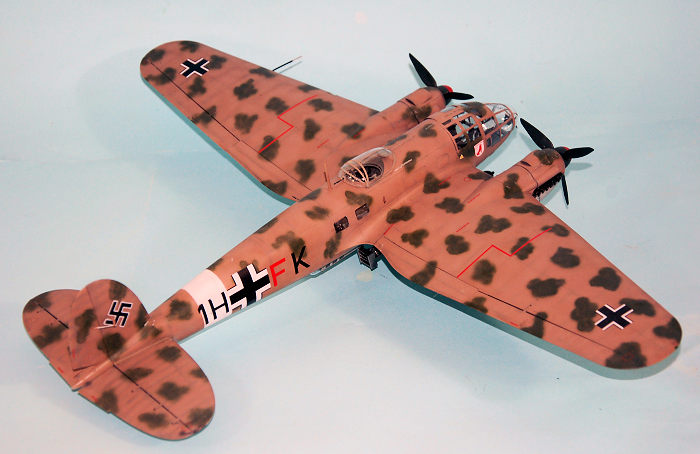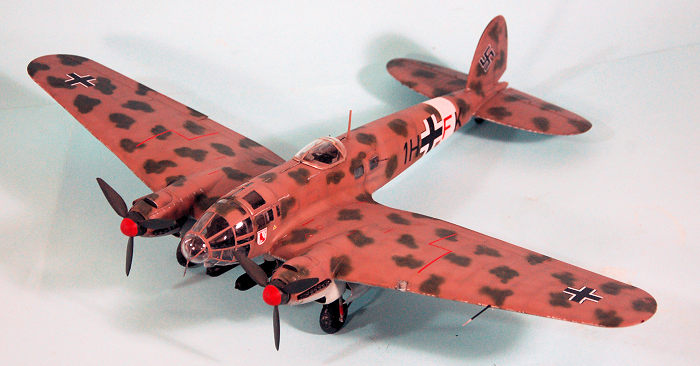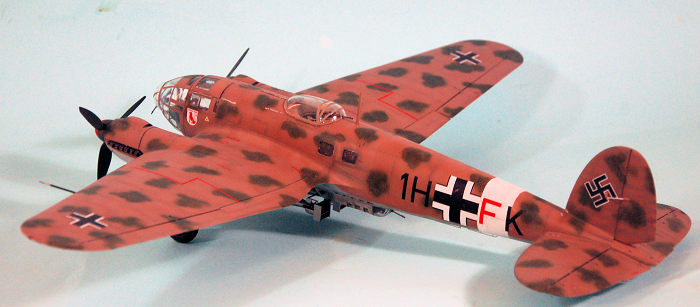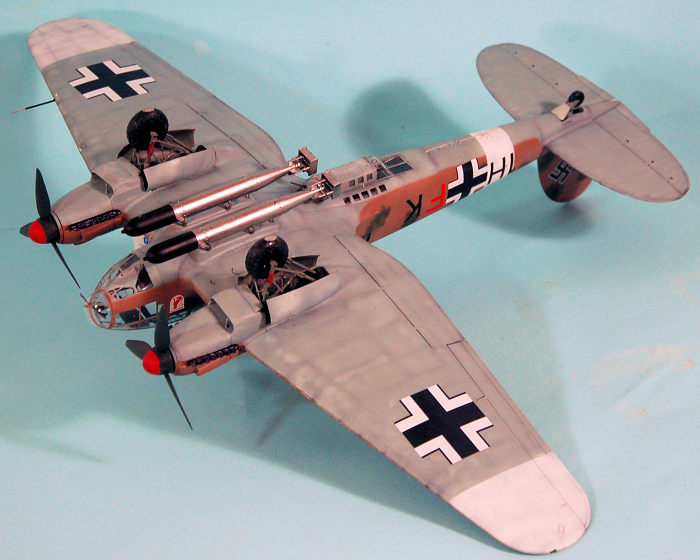
| KIT #: | 48265 |
| PRICE: | $81.99 |
| DECALS: | Three options |
| REVIEWER: | Tom Cleaver |
| NOTES: |

| HISTORY |
Appearing in 1934 as an ostensible “airliner,” the Heinkel He 111 was designed by Siegfried and Walter Günter. Because of restrictions prohibiting bombers placed on Germany after the First World War, it masqueraded as a civil airliner, although from its initial conception the design was intended to provide the nascent Luftwaffe with a fast medium bomber.
A design change in the cockpit layout introduced in the He-111P sub-type
made the airplane perhaps the best-recognized German bomber due to the
distinctive, extensively glazed "greenhouse." It was the most numerous Luftwaffe
bomber during the early stages of World War II and performed well until the
Battle of Britain, when its weak defensive armament was exposed. It did,
however, prove able to sustain heavy damage and remain
 airborne. Eventually, the
He 111 was used in a variety of roles on every front in the European theater:
strategic bomber during the Battle of Britain, torpedo bomber in the Atlantic,
Arctic, and Mediterranean, guided missile launcher with the V-1, and eventually
a transport aircraft on the Western, Eastern, Mediterranean, Middle Eastern, and
North African fronts.
airborne. Eventually, the
He 111 was used in a variety of roles on every front in the European theater:
strategic bomber during the Battle of Britain, torpedo bomber in the Atlantic,
Arctic, and Mediterranean, guided missile launcher with the V-1, and eventually
a transport aircraft on the Western, Eastern, Mediterranean, Middle Eastern, and
North African fronts.
Manufacture of the he-111 and every other piston-engine bomber was largely halted in September 1944 in favor of fighter aircraft.
Production of the He-111 continued after the war as the Spanish-built CASA 2.111. A batch of He 111H-16s were delivered in 1943, with an agreement for license production. It was produced in Spain by Construcciones Aeronáuticas SA. The design differed in powerplant only, eventually being equipped with Rolls-Royce Merlin engines. The aircraft saw operational service in the late 1950s during fighting in Spanish Morocco and continued in service until 1973, gaining an international reputation through its use in the motion picture “Battle of Britain,” made in 1967.
The He-111H series was the most-produced and saw the widest wartime service. Originally, the “H” was a direct modification of the “P” sub-type, in which the DB600 engines were changed to Jumo 211s due to the need of the Daimler-Benz engines for the Bf-109 fighter.
Beginning with the He-111H-4 that entered production after the Battle of Britain, ordnance-carrying ability was changed, The aircraft could either carry 4,410 lb of bombs internally or mount one or two external racks to carry one 3,970 lb or two 2,210 lb bombs. These external racks blocked the internal bomb bay doors, and a 221 US gallon tank was put in the space left vacant by the removal of the internal bomb-bay. Some H-4s had their PVC racks modified to drop torpedoes.
 The H-6 saw overall improvements in design, and used the Jumo 211 F-1
engine of 1,350 hp, while the defensive armament was upgraded at the factory
with an optional 20 mm MG FF cannon in the nose and/or gondola positions, two MG
15s in the ventral gondola fore and aft, and one MG 15 in on each side in side
windows. Some H-6 variants carried tail-mounted MG 17 defensive armament. The new
engines improved performance, with an improved rate of climb and a higher
operational ceiling of 27,000 ft. Some H-6s received Jumo 211F-2s which
increased low-level speed to 226 mph and high altitude speed to 270 mph at
19,000 ft.
The H-6 saw overall improvements in design, and used the Jumo 211 F-1
engine of 1,350 hp, while the defensive armament was upgraded at the factory
with an optional 20 mm MG FF cannon in the nose and/or gondola positions, two MG
15s in the ventral gondola fore and aft, and one MG 15 in on each side in side
windows. Some H-6 variants carried tail-mounted MG 17 defensive armament. The new
engines improved performance, with an improved rate of climb and a higher
operational ceiling of 27,000 ft. Some H-6s received Jumo 211F-2s which
increased low-level speed to 226 mph and high altitude speed to 270 mph at
19,000 ft.
The H-6 saw extensive use as a torpedo bomber. The Luftwaffe had found during tests in 1941 that the He-111 was an excellent torpedo bomber, and developed the capability, using the Italian Whitehead Fiume 1,870 lb torpedo, which had a range of 3 km (1.9 mi) at a speed of 25 mph. The torpedo was launched from an altitude of 40 m (130 ft) and air speed of 190 km/h (120 mph). The water depth had to a minimum of 15 m (49 ft).
The He 111 torpedo bomber, operated by KG 26, was committed to operations in the Arctic Ocean against the Arctic convoys traveling to the Soviet Union from North America and the United Kingdom. In June, 1942, I./KG 26 attacked Convoy PQ 17, sinking three ships and damaging three more. He-111s of III./KG 26 and torpedo-carrying Ju 88s of III./KG 30 sank 25 out of 35 merchant ships. Convoy PQ 18 was attacked between September 13-15, 1942, losing 13 out of 40 ships sunk. The attacks cost the Luftwaffe 40 aircraft, of which 20 were KG 26 He 111s; of the 20 crews, 14 were missing in the Arctic seas.
Anti-shipping operations in the Black Sea were also carried out. The Soviets mainly sailed at night and singly, making interception very difficult. On the morning of November 7, 1941, an He 111 of KG 26 sank the Soviet hospital ship Armenia off the coast of Crimea, killing at least 5,000 people.
 In the Mediterranean, KG 26 attacked Allied shipping along the African
coast, flying from bases in Sicily and Sardinia both in daylight and darkness.
Throughout 1941-1942, the small numbers of He 111s were used to attack Malta and
starve it into surrender. The KG 26 torpedo bombers came close to achieving this
by gradually strangling the sea supply routes and forcing a partial collapse of
British sea power in the central Mediterranean. The Allied forces on Malta were
considering surrender as late as November 1942, just before attacks ceased and
the siege was lifted.
In the Mediterranean, KG 26 attacked Allied shipping along the African
coast, flying from bases in Sicily and Sardinia both in daylight and darkness.
Throughout 1941-1942, the small numbers of He 111s were used to attack Malta and
starve it into surrender. The KG 26 torpedo bombers came close to achieving this
by gradually strangling the sea supply routes and forcing a partial collapse of
British sea power in the central Mediterranean. The Allied forces on Malta were
considering surrender as late as November 1942, just before attacks ceased and
the siege was lifted.
The KG 26 torpedo bombers continued to operate while German forces were in North Africa, attacking Allied shipping along the German coast. Such missions were largely abandoned in the spring of 1943 owing to shortages in aircraft and crews. By April, KG 26 could field 13 Ju-88 and He-111 torpedo bombers.
| THE KIT |
 The He-111 first appeared in 1/48 scale in the early 1990, released by
Monogram from molds purchased from Hobbycraft. The model was a mishmash of
sub-types, and could be built as an H-3 or H-6 with detail parts made by Bill
Koster. A final release was the He-111H-20 carrying a V-1 buzz bomb. The kits
are still available from dealers on eBay.
The He-111 first appeared in 1/48 scale in the early 1990, released by
Monogram from molds purchased from Hobbycraft. The model was a mishmash of
sub-types, and could be built as an H-3 or H-6 with detail parts made by Bill
Koster. A final release was the He-111H-20 carrying a V-1 buzz bomb. The kits
are still available from dealers on eBay.
ICM first released a modern kit of the He-111H in 1996, that being the H-3 sub-type used in the Battle of Britain. The He-111H-6 came out in 2018, and was re-released in 2019 with the option of mounting torpedos.
The kit is highly-detailed, with complete Jumo-211 engines that can be displayed without the cowlings. This provides an opportunity for a servicing diorama. The interior is fully detailed. The parts to do the He-111H-3 are also included. Decals provide markings for four aircraft used in North Africa, with one being a torpedo bomber used by KG 26 based in Sicily.
| CONSTRUCTION |
Once again, I committed the radical act of following the instructions in assembling this kit.
I determined to do as much painting as possible with the parts still on the sprues. The parts for the cockpit and that part of the fuselage halves were painted with Tamiya XF-63 “German Grey,” while the rest of the interior parts and the landing gear and gear bay parts were painted with Tamiya XF-22 “RLM Grey” lightened with XF-2 Flat White to get a more accurate shade.
 Assembly of the fuselage interior encountered no problems. Modern ICM
kits fit very nicely. I used Eduard seat belts for the pilot’s seat. After I
glued the fuselage halves together, I assembled the multi-part clear nose as
attached it. I left the bulbous nose gun mount off, to attach the gun later
after painting, and did the same with the upper and lower gun positions. I had
to insert the beam guns in position before attaching the side windows.
Assembly of the fuselage interior encountered no problems. Modern ICM
kits fit very nicely. I used Eduard seat belts for the pilot’s seat. After I
glued the fuselage halves together, I assembled the multi-part clear nose as
attached it. I left the bulbous nose gun mount off, to attach the gun later
after painting, and did the same with the upper and lower gun positions. I had
to insert the beam guns in position before attaching the side windows.
I assembled the wings around the substantial spars, per the instructions. This resulted in a strong structure with everything properly aligned. I used the lower center section with the mounts for the torpedoes. After I assembled the wings, I assembled the engine cowlings with only the engine block and mounts inside, to insure good fit of the cowlings. This was quite fiddly, but the result looked good. I finished off assembly with the tail, and also attached the landing gear at this point.
| COLORS & MARKINGS |
 The instructions call for the airplane to be painted RLM79 uppers and
RLM78 lowers. I suspect the airplane was actually left RLM65 lowers when it was
repainted in the field with desert camouflage, but I used my Tamiya mixes of
these two desert colors. The green blotches were done with Tamiya “Nato Green.”
The torpedoes were painted with Tamiya X-18 Semi-gloss Black, then with Vallejo
“Duraluminum.”
The instructions call for the airplane to be painted RLM79 uppers and
RLM78 lowers. I suspect the airplane was actually left RLM65 lowers when it was
repainted in the field with desert camouflage, but I used my Tamiya mixes of
these two desert colors. The green blotches were done with Tamiya “Nato Green.”
The torpedoes were painted with Tamiya X-18 Semi-gloss Black, then with Vallejo
“Duraluminum.”
I used the kit decals, with the addition of a swastika from an Aeromaster Swastika sheet. The new ICM decals work without any problems. I gave the model a coat of 50-50 thinned Tamiya “Clear Flat.”
| CONCLUSIONS |
These He-111 kits by ICM are more accurate than the Monogram kits, which are a mishmash of sub-types. The ICM kits contain parts specific for sub-types, such as propellers, spinners, exhausts, and armament. The kit is well designed and easy to assemble. Any average modeler who commits to following the instructions (since there are specific parts used for specific sub-types), will get a very nice result. Highly recommended.
7 November 2019
Copyright ModelingMadness.com
Thanks to ICM
for the review kit. If you would like your product reviewed fairly and
fairly quickly, please
contact
the editor
or see other details in the
Note to
Contributors.
Back to the Main Page
Back to the Review
Index Page
Back to the Previews Index Page